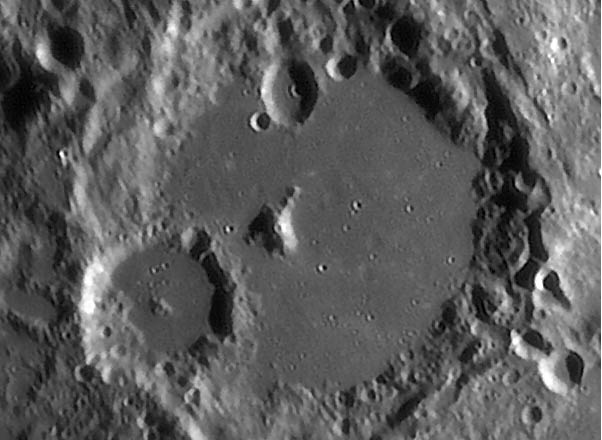Cups & Saucers

Explanation:
The word crater is Greek for cup, so it is not surprising that the much more shallow depressions on the floor of Ptolemaeus are called saucers. What is not widely known is that similar cups and saucers occur on the floor of Ptolemaeus near neighbor Albategnius. Like Ptolemy, Albategnius is a large, pre-Imbrium crater with an odd flat floor. Pre-Imbrium means that it already existed when the Imbrium basin formed 3.85 b.y. ago, and as a nearby witness, Albategnius was scarred for life. Paolos lovely image documents one linear chain of overlapping Imbrium secondary craters that creased the large craters northeastern rim. The floor of Albat (friends can have nicknames) is pocked with 10-20 small craters, and at least four (and maybe eight) very shallow saucers are also barely visible. These saucers are smaller in diameter than those in Ptolemaeus and are more difficult to detect. The explanation for the saucers in Ptolemy is that they are impact craters that formed on the the big craters floor, but were later covered by whatever the smooth material is. The most likely candidate (for both Ptolemy and Albat) is fluized ejecta from the Imbrium impact, otherwise it is some sort of unrecognzed volcanism, the standard refuge of stumped lunarians. Finally, I assume you notice the beautiful pit exactly at the summit of Albats (off)center peak? Opponents of lunar volcanism used to state that there were so many random impacts that a few should hit precisely on summits of central peaks. This laughable explanation is probably correct. Lunar central peaks are old rocks from depth that rebound up after an impact - they are not volcanoes. Secondly, notice how bright and fresh the summit pit is. If it were a volcano pit presumably it would be 3.5 b.y. old or so and would be rather degraded. This looks like a relatively fresh pit.
—
Chuck Wood
Technical Details:
18 March 2005. Planewton DL-252 telescope + Lumenera LU075 M camera + Edmund Optics R+IR filter; 200 of 4300 frames.
Related Links:
Paolo's Photo Gallery
